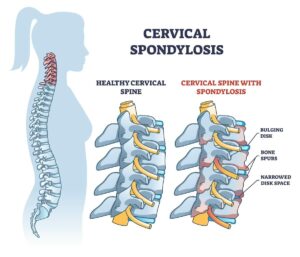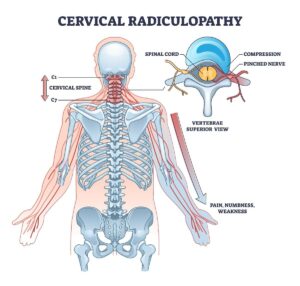Free download: Top 10 Natural & Easy Remedies for Joint Pain from Home. Learn these helpful remedies.
Ah neck pain…
While neck pain is unfortunately a very common occurrence, it seems to be one of the most challenging types of pain to get rid of! Why won’t it go away??
Whether or not your neck pain has just recently started or has become a chronic issue, most neck pain dilemmas have a common thread for why they hang around.
We’ll be taking a look at the top 5 reasons why your neck pain won’t go away and all of the contributing factors that could be causing your pain to go on.
Table of Contents
1. Posture
Why is it so hard to maintain a good posture? Because it takes more effort! Believe me, it’s worth the effort though.
You’ve probably heard over and over how important it is to maintain a good posture. There’s a reason for that! This could very likely be a reason why your neck pain won’t go away.
Allowing yourself to settle into a bad posture (e.g., hunched forward) creates all sorts of trouble for your body.
It removes the spine from a neutral alignment, placing more stress on the spinal joints, encourages muscles imbalances (e.g., certain muscle tightness develops, while other areas become excessively weak), and increases your chances of experiencing a strain, especially in the cervical spine, because you’re not positioning yourself in optimal alignment.
Upper crossed syndrome is one of the most common positional disorders that plagues most everyone. It essentially describes the common myofascial imbalances that develop due to the common forward head, rounded shoulders posture.
Specifically considering the neck, a forward head will cause the muscles in the back of the neck to become short and tight while the muscles in the front of the neck become long and weak. If not corrected, these imbalances can commonly lead to problems with neck pain and tension headaches.
The other areas affected in upper crossed syndrome, such as the rounded thoracic spine and tight chest muscles, can further exacerbate your neck pain and even lead to pain in those particular areas as well.
It’s a vicious cycle that must be corrected!
Exercise is a great start to correcting the posture. While there are many exercises that can be considered, take a look at the following two exercises to begin with.
When we’re dealing with some areas that are tight and others that are weak, you’ll want to improve the flexibility of the tight spots first. The purpose of this is to be able to move into correct alignment and then work on strengthening the right muscles to maintain that alignment.
a. Neck Flexion Stretch
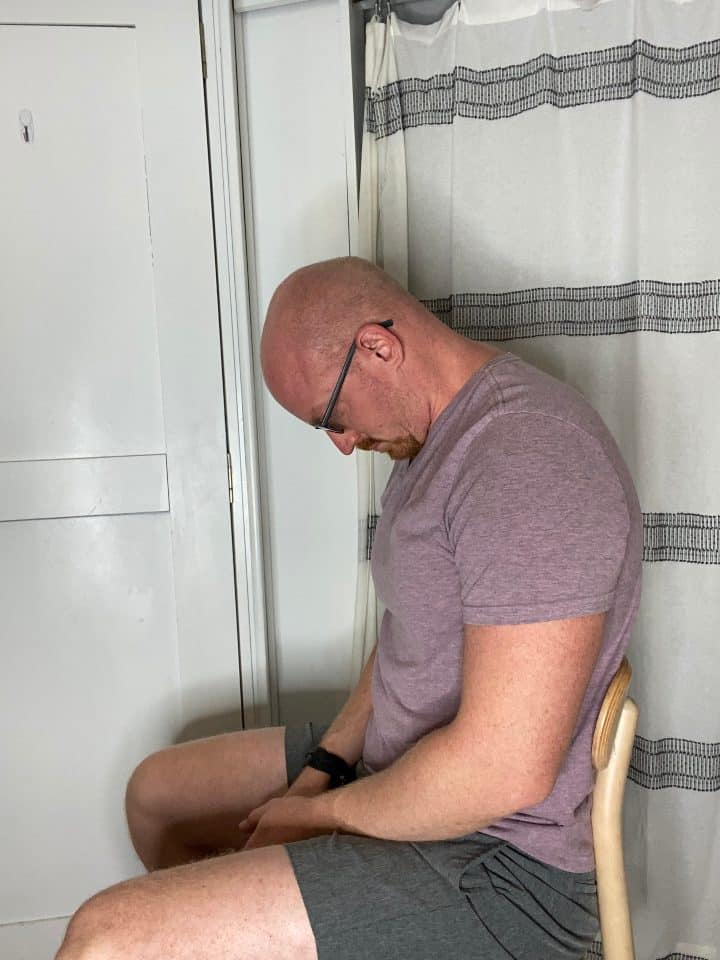
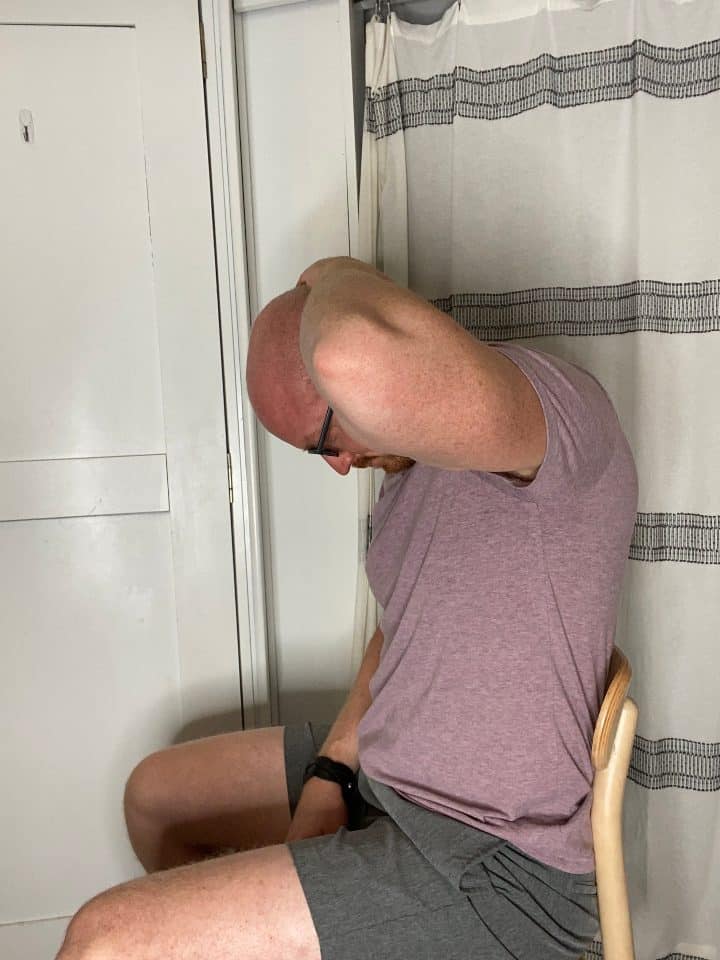
The focus of this stretch is to lengthen the tight muscles in the back of the neck that have resulted from your forward head posture.
- In sitting or standing, try to position your posture as upright as you can. Slowly allow the head and neck to bend forward, as if you’re looking down towards the floor.
- For a stronger stretch, you can use a hand and place it on the head to provide a bit of overpressure to your stretch.
- Hold for 20-30 seconds, then slowly return to your starting position.
- Repeat 2x.
b. Thoracic Extension in a Chair
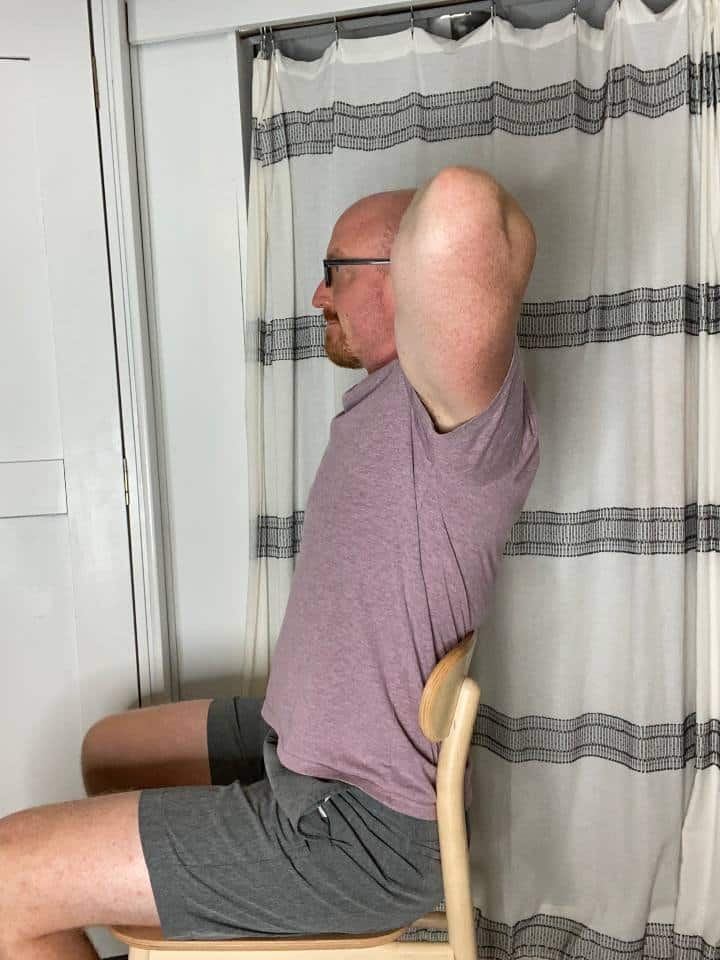
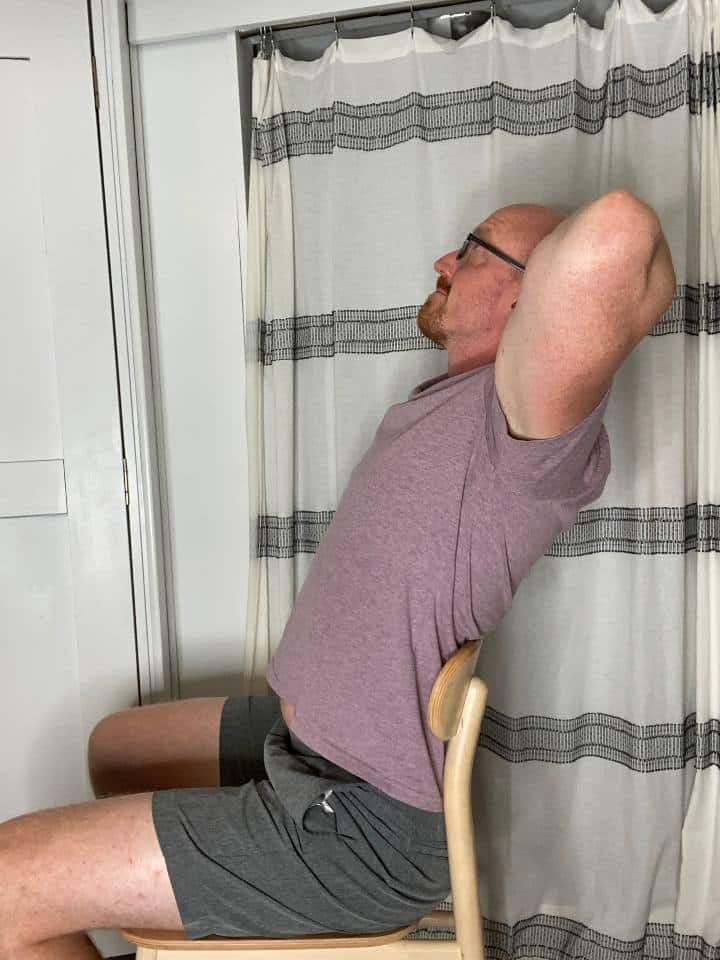
This one feels SO good.
- Find yourself a chair with a back to it that comes as high as your mid thoracic spine.
- Place your hands behind the head to cradle the head.
- While allowing the spine to press into the back of the chair, stretch back and allow the chest to open towards the ceiling. Let the head look up too while resting in your hands.
- Hold this stretch for 5 seconds, then return to an upright position.
- Repeat 10x.
These stretches can be super helpful for relieving muscle tension. Remember though, it’s okay if the stretch gets a little uncomfortable, but don’t stretch so far that it becomes painful!
For a demonstration showing two quick and easy steps to fix your posture, check out this video below. Sometimes practicing moving from an incorrect posture to the right posture will help you better identify the times when you do fall into a bad position and can sooner correct it.
A great compliment to a solid stretching routine is adding in some foam rolling. You don’t necessarily have to foam roll the neck directly, but many times foam rolling over the thoracic spine will open up the posture and help to relief those tight neck muscles.
Here’s a quick look at how to use a foam roller to release the thoracic spine.
2. Sleeping Position
Have you ever woken up with a kink in the neck?
Neck stiffness and persistent pain could very well be related to your sleeping position.
A poor sleeping posture can be a common cause of why your neck pain won’t go away, but can be fixed with the right kind of supportive pillow! This might take a little experimentation on your end though to find that perfect pillow support.
To help guide you with finding the right pillow and position for the neck overnight, let’s break down each of the primary sleeping positions most find themselves in.
a. Back Sleepers

If you’re more comfortable sleeping on your back, here’s your potential dilemma when it comes to your pillow.
If your pillow is too thick, it will tend to place your head and neck excessively forward. If your pillow is too thin, it will likely place your neck into a bit of hyperextension.
b. Side Sleepers
No matter which side you sleep on, here’s what could happen with the wrong pillow.
If your pillow is too thick or too thin, it will place your head in excessive side bending.

For example, if you sleep on your left side with a very thick pillow, this will position your neck into a position of excessive right side bending.
When you wake up in the morning, you’ll likely have neck pain on the right side of your neck because it was placed in a shortened position for the muscles overnight.
Let’s consider again that you’re sleeping on your left side, but this time with a thin pillow. Now your neck will likely fall into excessive left side bending. When you wake up in the morning, you’ll likely have neck pain and tightness on the left side of your neck.
Side sleepers commonly suffer from excessive muscle tension and a crick in the neck on one side of the neck, such as in the examples above, because with the wrong pillow your neck will be positioned too far to one side.
So, the main point for side sleepers is to make sure that the pillow you’re using places the neck in a neutral position versus bending towards one side.
c. Stomach Sleepers
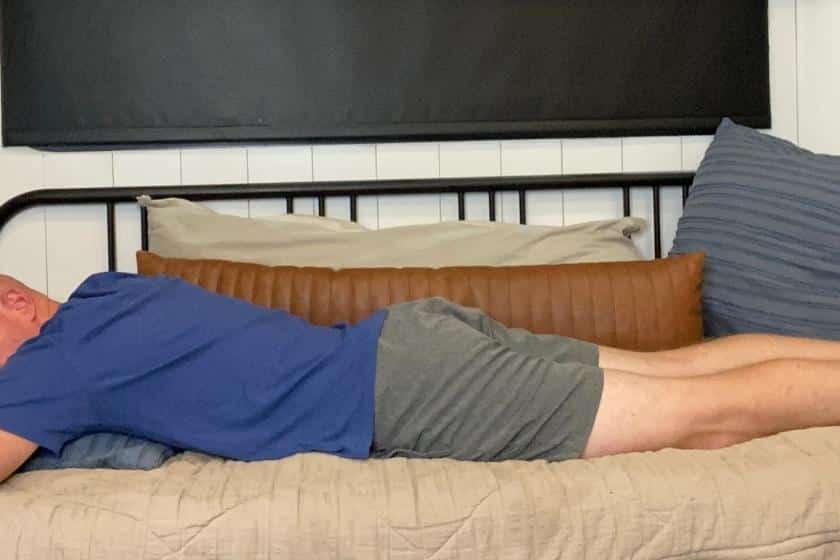
Many of us are guilty of sleeping on our stomachs, but in reality, this is probably the one position we should really try to avoid if at all possible.
Sleeping on the stomach places the most stress and strain on the spine, including the neck.
Unless you sleep face down (I hope you don’t!), you’ll have to turn your head to one side while you’re sleeping on the stomach. This automatically removes your neck from a neutral position.
The situation gets worse if your pillow is too thick or too thin. Particularly with a pillow that’s too thick while sleeping on the stomach, you’re at a greater risk of causing a compressed nerve.
This could cause you to wake up with numbness and/or tingling down an arm.
If you can, do your best to avoid sleeping on the stomach altogether. Your body will thank you for it later!
Since we’re talking about sleeping, it’s also worth it to mention the type of mattress you’re using.
Maybe you’ve fixed the problem of your pillow and sleeping position, but you’re still having neck pain. It could be your mattress!
If your mattress is very old, you may simply need to update it. The type of mattress could be the issue though as well. Your usual options will include a soft, medium or firm mattress, or even a combination of these.
Some type of medium firm mattress is usually a safe bet to go with, but ultimately you have to find what works best for you.
3. Lack of Exercise
That’s right, a lack of exercise can absolutely be a reason why your neck pain won’t go away.
Our bodies crave movement! This is what keeps us going and keeps our joints and soft tissues healthy and strong. Without it, we’re bound to start experiencing pain and stiffness.
The neck is no exception to this.
Many studies have found that active movement is one of the best treatment methods for addressing neck pain. This is why it’s becoming more common for your doctor to refer you to medical professionals, such as physical therapists, to address your neck pain, whether it’s a new issue or chronic neck pain.
The right exercise routine will promote a balance of flexibility and strength, while naturally encouraging healthy blood flow and circulation to the area at work. This will ensure the right nutrients are being brought to that area for a healthy, happy body.
Sometimes it can be challenging to know what the right type of exercise routine is and maybe this is what’s keeping you from starting one. That’s okay!
There are many professionals out there who can help you get started with the right exercise routine, such as in physical therapy or personal training.
Keying in on the neck specifically, we’ll look at a couple of easy strengthening exercises great to help reduce and prevent neck pain.
a. Chin Tuck


A chin tuck is an easy exercise to strengthen the neck muscles called the neck flexors located in the front of the neck. This is a nice compliment to the neck flexion stretch we talked about earlier to fix a forward head posture.
- You can practice a chin tuck either laying down, in sitting or standing.
- To properly perform a chin tuck, simply retract the chin back as if you’re trying to make a double chin. Make sure to avoid nodding the head as if you’re saying yes.
- Once you retract the chin with a light force, hold this position for up to 5 seconds, then return to a relaxed state.
- Repeat 10-15x for 2-3 sets.
b. Reverse Corner Pushout
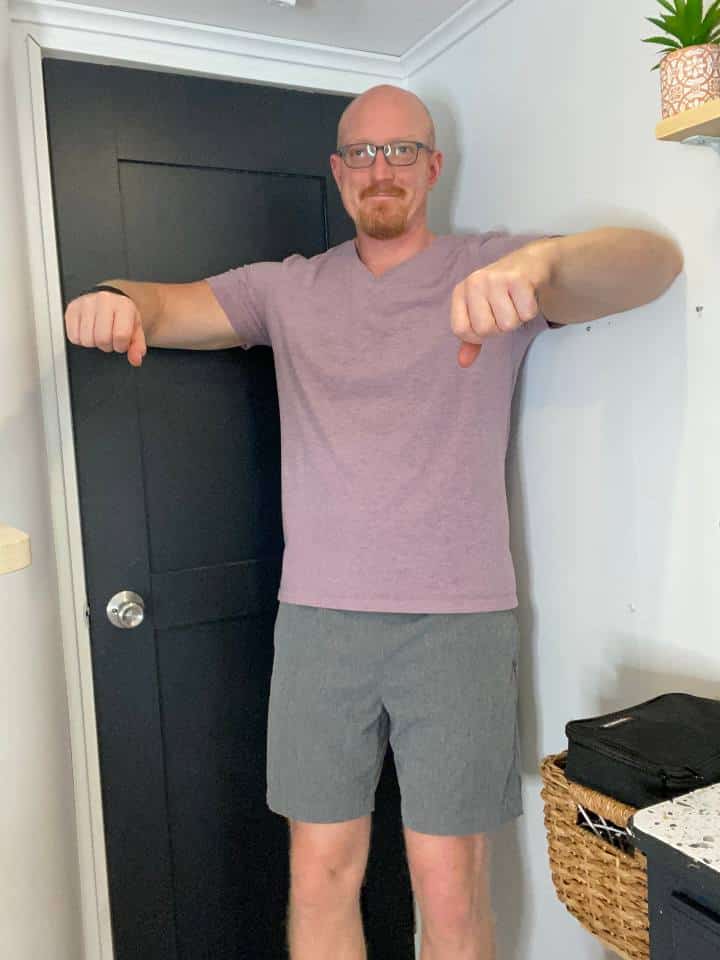
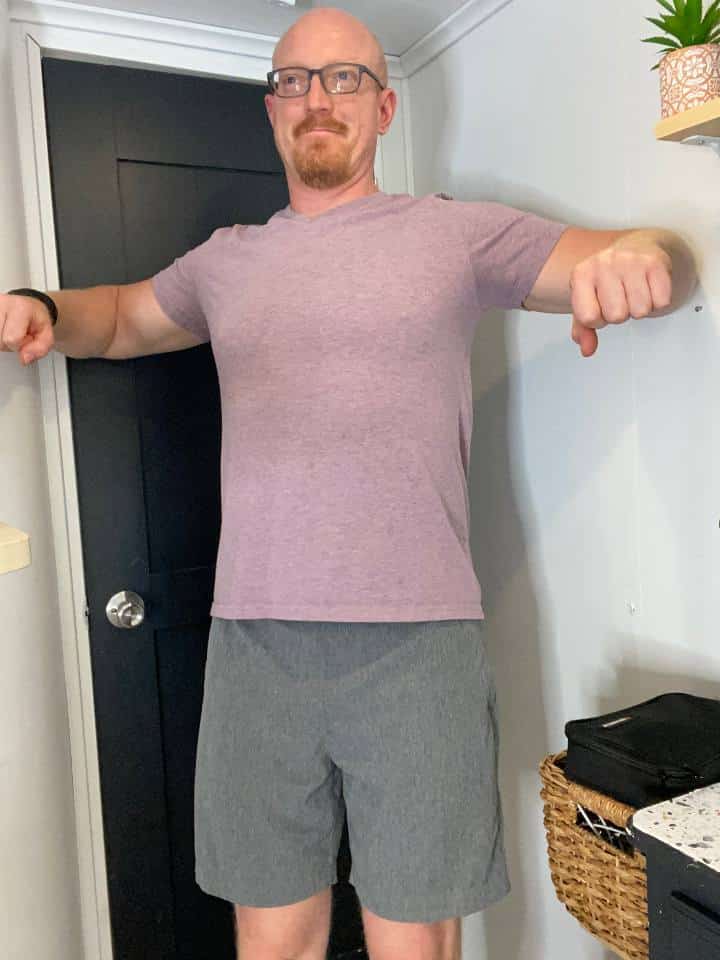
This exercise keys in on strengthening the muscles in the upper back around the shoulder blades. Strong muscles in this area will help you avoid ending up in a hunched forward posture.
- Find a corner in your home to do this exercise. With your back against the corner, lean into it, allowing your feet to be positioned slightly in front of you about 2-3 inches from the wall.
- Position your arms so that the elbows are bent and raised to about shoulder height, pressed against the wall.
- Gently press the elbows against the wall while pushing yourself out of the corner. Your feet won’t move during this.
- Once you’ve pushed away from the wall, slowly lower yourself back into the corner.
- Repeat 10-15x for 2-3 sets.
In case this last exercise is a little harder to visualize, here’s a full demonstration.
4. A Bigger Underlying Problem
Your neck pain not going away doesn’t automatically mean there is a more serious issue going on; however, if your neck pain is present with other symptoms, then the neck pain itself may not be the primary issue. It may be occurring as a result of another problem in the body.
A simple possibility is that your neck pain may not be from a muscle tension issue but could be early signs of neck arthritis. As we get older, it’s pretty normal for our joints to experience normal wear and tear, with the neck being no exception.
Imaging and a thorough exam from your doctor and a physical therapist can help confirm if you’re dealing with neck arthritis and help you learn how to manage it.
Sometimes neck pain can be referred pain from other areas of the body. For example, many with shoulder injuries or dysfunctions will also experience neck pain.
This neck pain may not have started at the same time as the shoulder pain though, which can make it difficult to recognize the association between the two.
It’s a possibility that you may start with a simple case of neck pain, however, begin gradually noticing other symptoms, such as a radiating pain down the arms or numbness and/or tingling in the hands.
This is usually a sign of a pinched nerve in the spine. A pinched nerve could be related to a herniated disc, cervical arthritis, spinal stenosis, etc.
Believe it or not, our internal organs can send referred pain to different parts of the body. We recognize the referred pain where it’s affecting us but may not realize right away that it’s coming from a different source.
Because there are many possible causes to ongoing neck pain, if your pain is persisting, then it’s important to let your doctor know so they can help figure out the cause.
The goal of this section isn’t to cause you to panic or to think that any time you have neck pain there is a bigger problem going on. It is important though to recognize certain red flags, as these can be indicators that more than just a simple kinked neck is going on.
If you notice any of the following in association with your neck pain, you should seek emergency services right away:
- Sudden onset of numbness and/or tingling down the arms
- Sudden shooting pain down the arms
- Sudden onset of a headache or migraine
- Changes in vision
- Dizziness
- Suddenly dropping objects
- Sudden arm weakness
- Sudden inability to move the head or neck
The concern with these specific symptoms is that something much more serious may be occurring such as spinal cord compression, circulatory obstruction, or systemic dysfunction.
Another though to consider is that if you’ve experienced a recent trauma in relation to the start of your neck pain, you should see your doctor for a more thorough examination right away.
This could include a recent sports injury, fall or car accident. It’s important in instances of a known injury to avoid waiting to be checked out, otherwise, your symptoms could very likely get worse and make recovery that much more difficult.
5. Stress
Let’s not kid ourselves here, stress is a very common cause of muscle tension and neck pain.
Stressful triggers could include problems at work, struggling to find that work/life balance, someone close to you being ill, trying to manage your family, financial strains, and more. The list could go on and on.
The problem is that if you’re constantly stressed, more often than not it will manifest itself physically, such as with neck pain.
Because stress is a possible reason why your neck pain won’t go away, it’s important to recognize those stressful triggers and figure out how to control them.
This might include making changes to your work schedule, finding some quiet time during the day to breathe and relax, taking part in an activity that allows you to decompress like yoga or meditation, or maybe having to say no to doing certain things because you’re getting overwhelmed.
Whatever you need to do, find what works best for you. By doing so, you’ll probably begin noticing less neck stiffness and muscle strain throughout the day. Your neck muscles will be so grateful!
Take Home Points

There are many reasons why your neck pain won’t go away.
Poor posture, an unsupportive sleeping position, lack of exercise, referred pain, and stress are just a few examples of what could be plaguing the cervical spine and neck muscles.
While simple home remedies such as exercise, stretching, foam rolling, resting, heat and ice can be beneficial for simple mechanical neck pain, it’s important to know when to see your doctor.
If other symptoms, especially red flags, begin showing with your neck pain, and you don’t address them right away, there could be some serious consequences to delaying treatment.
In cases with red flags or timing with a recent injury, make sure to seek emergency services or your doctor right away, respectively.
Neck pain doesn’t have to be something you live with forever. Help and healing is possible!
FAQ:
Is massage good for neck pain?
It definitely can be! If your neck pain is related to muscle stiffness and tension, then receiving regular massages can be very helpful for pain relief.
Will I need surgery for my neck pain?
Not necessarily.
If you have persistent, intense neck pain and nerve symptoms, like numbness or tingling, that won’t go away, then a neurosurgeon may recommend surgery. If you’re in a more emergency circumstance with red flags, then surgery may be needed as well. For standard neck pain related to muscle tension, surgery usually isn’t necessary.
How long will neck pain last?
This can vary with each person, depending on the exact cause of pain. The sooner you address your pain though, the quicker your recovery will be.














